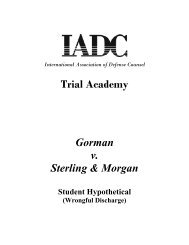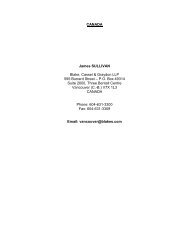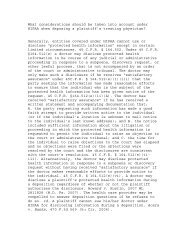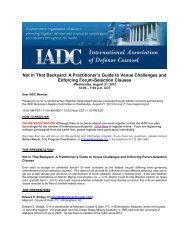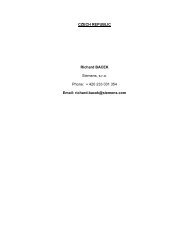Defense Counsel Journal - International Association of Defense ...
Defense Counsel Journal - International Association of Defense ...
Defense Counsel Journal - International Association of Defense ...
You also want an ePaper? Increase the reach of your titles
YUMPU automatically turns print PDFs into web optimized ePapers that Google loves.
Fending <strong>of</strong>f the Use <strong>of</strong> a Rule 12(f) Page 453prejudice by providing the plaintiff withnotice and the opportunity to demonstratewhy the affirmative defense should notsucceed.” 85 Where a defendant haspleaded an affirmative defense, he has putthe plaintiff on notice, and avoidedprejudice. 86In denying plaintiff’s motion to strikeaffirmative defenses in Ailey v. MidlandFunding, LLC, the district court statedthat plaintiff had failed to show howprejudice would result from leaving thedefenses in the pleadings, especially inlight <strong>of</strong> the fact that the defendant had theburden <strong>of</strong> pro<strong>of</strong>, and that “there can be noharm in letting them remain in thepleadings if, as the plaintiff contends,they are inapplicable.” 87 Therefore, areviewing court must exercise commonsense and practicality in any Rule 12(f)motion and consider if there is anyprejudice to the moving party. 88Where the basis for an affirmativedefense is readily apparent, there is noprejudice shown, and only furtherdiscovery can determine whether anaffirmative defense is valid. All thatshould be required is that the affirmativedefense “provid[e] knowledge that theissue exists, not precisely how the issue isimplicated under the facts <strong>of</strong> a givencase.” 89 The fact that a plaintiff mayclaim that they are unaware <strong>of</strong> whichaffirmative defenses apply to whichclaims is a matter to be settled indiscovery, rather than a reason toprematurely strike the entire defense. 90The favored course should not be to strikeaffirmative defenses prematurely, butrather to allow a clearly plead affirmativedefense to stand, pending discovery.VI. CONCLUSIONFair notice has long been the test <strong>of</strong>affirmative defenses, and neitherTwombly nor Iqbal has expressly alteredthat standard. Both textual and practicalrealities <strong>of</strong> pleading lend support to theposition expressed herein, that theheightened plausibility standard shouldnot be applied to affirmative defenses.85 Robinson v. Johnson, 313 F.3d 128, 134-135 (3rd Cir. 2002).86 See Haley Paint Co., 279 F.R.D. at 337(noting that plaintiffs “have articulated noprejudice that would result from a denial <strong>of</strong>their motion [to strike affirmative defenses]”).87 No. 3:11-CV-77, 2011 WL 3049283, *4(E.D. Tenn. July 25, 2011) (quotingConocophillips Co. v. Shafer, No. 3:05 CV7131, 2005 WL 2280393, *2 (N.D. Ohio.Sept. 19, 2005)).88See WRIGHT AND MILLER, FEDERALPRACTICE & PROCEDURE, § 1381 (3d. ed.2009) (“even when technically appropriate andwell-founded, Rule 12(f) motions <strong>of</strong>ten are notgranted in the absence <strong>of</strong> a showing <strong>of</strong>prejudice to the moving party”).89 See Victaulic, 777 F. Supp.2d at 901.90 Id.



